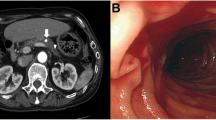Abstract
Hemosuccus pancreaticus (HP) is defined as gastrointestinal bleeding via the pancreatic duct and duodenal papilla. Since the bleeding is usually intermittent, it often remains undetected by endoscopy. Most cases are diagnosed by contrast-enhanced computed tomography (CT) or angiography, and the first-line treatment is transarterial embolization (TAE). However, in general, these modalities require a large amount of iodinated contrast medium. Here, we report the case of a 50-year-old female with HP due to chronic pancreatitis. Contrast-enhanced CT and ordinary angiography were contraindicated for her, as she was allergic to iodine. She was diagnosed with HP following gadolinium-enhanced magnetic resonance imaging and successfully treated by TAE of the splenic artery with metallic coils using carbon dioxide as the contrast medium.

Similar content being viewed by others

References
Kirby JM, Vora P, Midia M et al (2008) Vascular complications of pancreatitis: imaging and intervention. Cardiovasc Interv Radiol 31(5):957–970
Bergert H, Dobrowolski F, Caffier S et al (2004) Prevalence and treatment of bleeding complications in chronic pancreatitis. Langenbeck Arch Surg 389(6):504–510
Hsu JT, Yeh CN, Hung CF et al (2006) Management and outcome of bleeding pseudoaneurysm associated with chronic pancreatitis. BMC Gastroenterol 11(6):3
Pilleul F, Beuf O (2004) Diagnosis of splanchnic artery aneurysms and pseudoaneurysms, with special reference to contrast enhanced 3D magnetic resonance angiography: a review. Acta Radiol 45(7):702–708
Koizumi J, Inoue S, Yonekawa H et al (2002) Hemosuccus pancreaticus: diagnosis with CT and MRI and treatment with transcatheter embolization. Abdom Imaging 27:77–81
Tsuchiya K, Aoki C, Hachiya J (2004) Evaluation of MR cisternography of the cerebellopontine angle using a balanced fast-field-echo sequence: preliminary findings. Eur Radiol 14(2):239–242
William GB (1993) MR appearance of hemorrhage in the brain. Radiology 189(1):15–26
de Perrot M, Berney T, Bühler L et al (1999) Management of bleeding pseudoaneurysms in patients with pancreatitis. Br J Surg 86(1):29–32
Seeger JM, Self S, Harward TRS et al (1993) Carbon dioxide gas as an arterial contrast agent. Ann Surg 217(6):688–698
Terayama N, Matsui O, Ueda F et al (2004) CO2 demonstration of multiple extravasations into a subcapsular hematoma of the liver. Cardiovasc Interv Radiol 27(3):278–281
Author information
Authors and Affiliations
Corresponding author
Rights and permissions
About this article
Cite this article
Miki, S., Mori, K., Masanari, S. et al. Hemosuccus Pancreaticus in a Patient with Iodine Allergy: Successful Diagnosis with Magnetic Resonance Imaging and Treatment with Transarterial Embolization Using Carbon Dioxide as the Contrast Medium. Cardiovasc Intervent Radiol 32, 1296–1299 (2009). https://doi.org/10.1007/s00270-008-9488-0
Received:
Revised:
Accepted:
Published:
Issue Date:
DOI: https://doi.org/10.1007/s00270-008-9488-0



